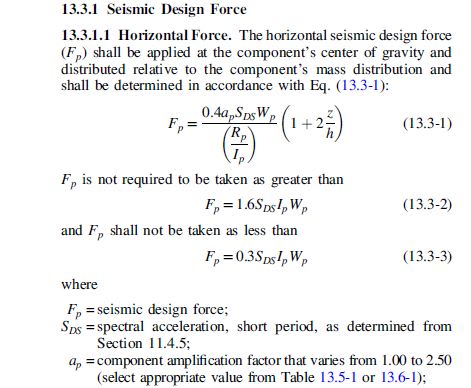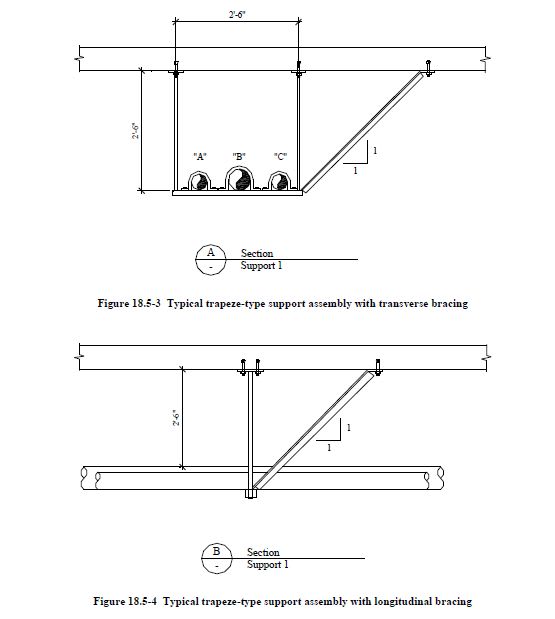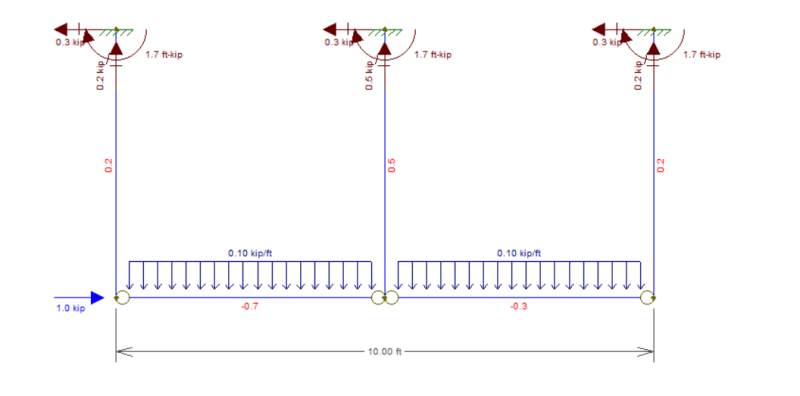Navigation
Install the app
How to install the app on iOS
Follow along with the video below to see how to install our site as a web app on your home screen.
Note: This feature may not be available in some browsers.
More options
Style variation
-
Congratulations TugboatEng on being selected by the Eng-Tips community for having the most helpful posts in the forums last week. Way to Go!
You are using an out of date browser. It may not display this or other websites correctly.
You should upgrade or use an alternative browser.
You should upgrade or use an alternative browser.
seismic lateral load distribution for 3 hangers
- Thread starter johndeng
- Start date
- Status
- Not open for further replies.
kissymoose
Structural
Lol, this reads a lot like a school question.
I assume the member is axially stiff enough to just distribute the load equally to each support, so 33lbs. But the difference is minute, so does it matter?
I assume the member is axially stiff enough to just distribute the load equally to each support, so 33lbs. But the difference is minute, so does it matter?
- Thread starter
- #3
Since the middle hanger takes 1/2 the vertical load, we can assume there are 2 simply supported beams connected to the hanger. This means connections at the top of hangers must be fixed to the supports.
Assuming each hanger is the same member size, each hanger takes 1/3 of horizontal load.
Assuming each hanger is the same member size, each hanger takes 1/3 of horizontal load.
JoshPlumSE
Structural
I don't generally view "hangers" as part of the lateral force resisting system. Certainly in the hospital work that I've done, we're required to put in a series of diagonal cables to take ALL of the lateral force. I can't imagine designing something that weighs 1000 lbs on hangers without some bracing or cables to take the lateral load.
- Thread starter
- #7
Yes assume connections at the top of hangers fixed to the supports.
Each hanger is the same member size. Please advise.
I feel it's 33 lbs due to same rigidity. But for a port frame, edge columns are always assumed to take half lateral load of the interior, also lateral is percentage of dead load supported.
33 lbs supporter: kissymoose CDLD
50 lbs supporter: rb1957
Unkown: JoshPlumSE
Each hanger is the same member size. Please advise.
I feel it's 33 lbs due to same rigidity. But for a port frame, edge columns are always assumed to take half lateral load of the interior, also lateral is percentage of dead load supported.
33 lbs supporter: kissymoose CDLD
50 lbs supporter: rb1957
Unkown: JoshPlumSE
WesternJeb
Structural
Johndeng, are you referring to lateral loads from a flexible diaphragm induced be seismic forces? That seems to be what you are trying to lead to in your previous post. If that is the case, then this is much more complicated than how you describe it with simple hangers connected by some beams.
- Thread starter
- #10
@WesternJeb
Let say the 3 hangers fixed on roof. Lateral load is due to the 1000 lbs weight they are hanging. Middle hanger supporting 500 lbs weight, side hangers 250 lbs each.
If you think of the rigidity of the 3 hangers, you think each takes 33 lbs lateral load.
If you separate each hanger, the middle hanger takes 500 lbs weight, lateral load is 0.1*500 lbs = 50 lbs.
Let say the 3 hangers fixed on roof. Lateral load is due to the 1000 lbs weight they are hanging. Middle hanger supporting 500 lbs weight, side hangers 250 lbs each.
If you think of the rigidity of the 3 hangers, you think each takes 33 lbs lateral load.
If you separate each hanger, the middle hanger takes 500 lbs weight, lateral load is 0.1*500 lbs = 50 lbs.
- Thread starter
- #12
SWComposites
Aerospace
Why care? just size each hanger for 50 lbs lateral load and be done with it.
- Thread starter
- #14
HTURKAK
Structural
- Jul 22, 2017
- 3,361
Your statement 'the middle hanger takes 500 lbs vertical dead load' implies the member supported with equal spans . The upper and lower limits would be ;
- If we assume the member flexible , and hangers axially rigid, the middle hanger takes (5/8)*1000= 625 lbs vertical dead load, while side hangers take (3/8)*500= lbs
- If we assume the member rigid relative to the axial rigidity of hangers , all hangers will take 1000/3 =333 lbs ,
- If we assume the member axially rigid , and the total lateral seismic load is 100 lbs, the lateral load at hangers, 33.3 lbs.
I assume ASCE 7-16 Section 13.3 ( SEISMIC DEMANDS ON NONSTRUCTURAL COMPONENTS ) is applicable .

If the max . force is more than 5 times of minimum, and the calculation is based on a lot of assumptions , i would go with max . force.
But don't forget to provide bracings ( transversal and longitudinal ) since the seismic force will be resisted by bracings not hangers.

Use it up, wear it out;
Make it do, or do without.
NEW ENGLAND MAXIM
WesternJeb
Structural
johndeng said:If you think of the rigidity of the 3 hangers, you think each takes 33 lbs lateral load.
Disagree with this. Elongation (gravity load) is based on PL/AE, which is the area of the section.
Bending deflection (lateral load) is based on the moment of inertia in the direction of the force.
You could have some wide flanges that are much stronger in the axial direction but relatively the same moment of inertia in the weak direction.
- Status
- Not open for further replies.
Similar threads
- Replies
- 6
- Views
- 11K
- Question
- Replies
- 0
- Views
- 3K
- Question
- Replies
- 0
- Views
- 6K
- Replies
- 21
- Views
- 5K
- Locked
- Question
- Replies
- 4
- Views
- 3K

